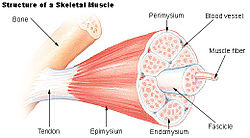Endomysium
| Endomysium | |
|---|---|
 Structure of a skeletal muscle. (Endomysium labeled at bottom center.) | |
| Identifiers | |
| TA98 | A04.0.00.043 |
| TA2 | 2007 |
| TH | H3.03.00.0.00004 |
| FMA | 9729 |
| Anatomical terminology | |
The endomysium, meaning within the muscle, is a wispy layer of
Endomysium combines with perimysium and epimysium to create the collagen fibers of tendons, providing the tissue connection between muscles and bones by indirect attachment.[4] It connects with perimysium using intermittent perimysial junction plates.[5]
Collagen is the major protein that composes connective tissues like endomysium.[6] Endomysium has been shown to contain mainly type I and type III collagen components, and type IV and type V in very minor amounts.[7] Others have found type IV and type V more common.[2]
The term cardiac skeleton is sometimes considered synonymous with endomysium in the heart, but cardiac skeleton also refers to the combination of the endomysium and perimysium.
Clinical significance
See also
- Connective tissue in skeletal muscle
- Epimysium
- Perimysium
References
- ISBN 978-0-12-386860-2, retrieved 2020-11-02
- ^ ISBN 978-0-7020-4430-4, retrieved 2020-11-02
- ISBN 978-0-7020-3377-3, retrieved 2020-11-02
- ^ Saladin, K. S. (2012). Anatomy and Physiology: The Unity of Form and Function. New York, NY: McGraw-Hill.[page needed]
- ISBN 978-0-7020-3425-1, retrieved 2020-11-02
- ISBN 978-0-12-397157-9, retrieved 2020-11-02
- PMID 6743238.
- ISBN 978-0-08-097037-0, retrieved 2020-11-02
- PMID 9518950. Archived from the originalon 2020-05-28. Retrieved 2015-05-23.
External links
- UIUC Histology Subject 777
- Illustration at wku.edu
- Anatomy photo: Musculoskeletal/muscle/skeletal1/skeletal3 - Comparative Organology at University of California, Davis
- MedEd at Loyola histo/practical/muscle/hp7-42.html
